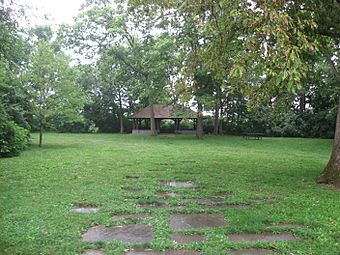Madisonville Site facts for kids
Quick facts for kids |
|
|
Mariemont Embankment And Village Site
|
|

Overview of the site
|
|
| Location | Southern side of Mariemont, above the Little Miami River |
|---|---|
| Nearest city | Mariemont, Ohio |
| Area | 6 acres (2.4 ha) |
| NRHP reference No. | 74001517 |
| Added to NRHP | October 16, 1974 |
The Madisonville Site is an ancient archaeological site located near Mariemont, Ohio, in the United States. It's a special place where archaeologists study the past. This site was added to the National Register of Historic Places on October 16, 1974, under the name "Mariemont Embankment and Village Site."
Contents
Discovering the Madisonville Site
The Madisonville Site is very important for understanding the Fort Ancient culture. It's known as the main example, or "type site," for a period called the Madisonville phase of Fort Ancient pottery. This means many discoveries here help us understand that specific time.
The site covers about 5 acres and sits on a high cliff above the Little Miami River. This spot is about 5 miles upstream from where the Little Miami River joins the Ohio River. People lived here for hundreds of years. However, it was most busy during the late 1500s and early 1600s. It is the most studied Fort Ancient site from this time.
Uncovering History: Excavations at Madisonville
In the early 1900s, experts from the Peabody Museum of Archaeology and Ethnology at Harvard University started digging here. They carefully uncovered many artifacts and learned a lot about the people who lived at Madisonville.
Since 1990, the Cincinnati Museum of Natural History has continued these studies. They use modern tools and methods, which has helped them learn even more. For example, they found that the village had two or more small open areas, called plazas. Earlier Fort Ancient villages, like SunWatch Indian Village, usually had just one central plaza.
What Did They Eat?
The people at Madisonville had a varied diet. They grew maize (corn), which was a very important food source. They also hunted animals to add to their meals.
Bison and Other Game
Researchers believe this is the only Fort Ancient site where people ate bison. They might have hunted these large animals in areas west of the site. Elk and deer were also important for their meat. Besides food, these animals provided other useful things. People used their bones, tendons, and hides to make tools, musical instruments, clothing, and ornaments.
Connecting with Others: Trade and Exchange
Archaeologists found many items at Madisonville that were not from the local area. This shows that the villagers were part of a large network where they traded goods with other groups.
Goods from Far Away
Items found at the site came from places as far away as the Saint Lawrence River region, near the New York and Canadian border. Other goods came from eastern present-day Iowa, northern Alabama, and Tennessee. The types and limited number of European goods found suggest that the Madisonville people traded indirectly for them. This means they likely got these items from other Native American groups, not directly from Europeans.
Unique Ornaments
The people at Madisonville made special snake-shaped ornaments. These unique ornaments have been found at other sites far away. For example, they have been discovered in Iroquois settlements in Ontario, Canada, and western present-day New York. This shows how far their influence and trade connections reached.



